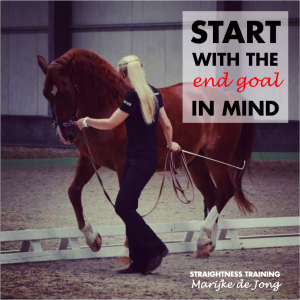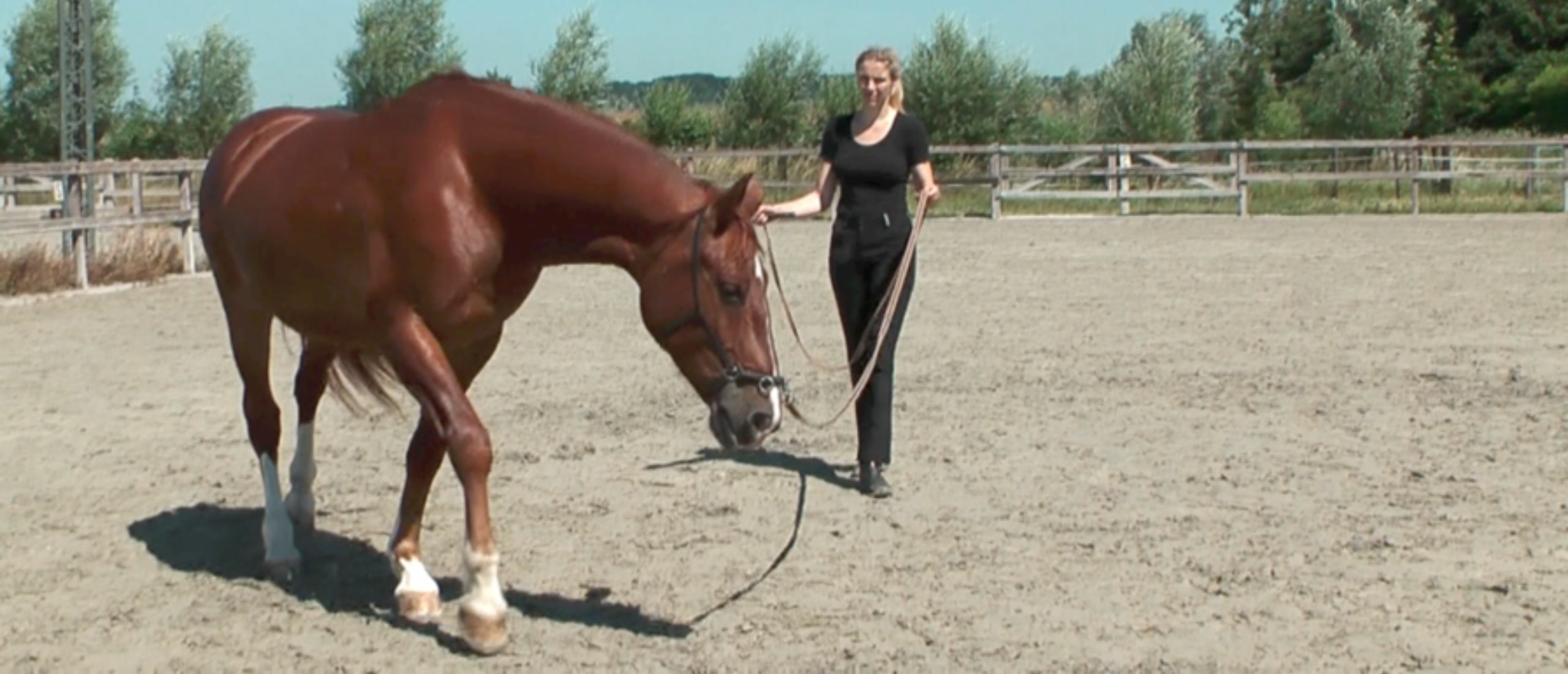When riders start to get enthusiastic about Straightness Training, the most common questions are:
- Where do I start?
- How often do I need to train?
- How many days a week?
- How many minutes a day?

Here are 6 tips to get a grip on how train your horse with ST!
Tip #1: Start with the"Bigger Picture" in mind
When you want to start practicing Straightness Training TODAY, you need to know the Bigger Picture, so you'll start with the end goal in mind, so you'll know what to expect along the way, and what the logical system of progressive exercises and training pillars is all about. This video gives you a quick overview to give you a clear overview of training components and exercises:
Now that the "Bigger Picture" is clear, let's see how we can start training TODAY, and how we can make a first step towards our goal.
Tip #2: Decide what TODAY's goal is
 A daily training session is not an isolated event, but part of the long-term educational program of the horse. With the end goal in mind, you can start to define your goal for TODAY. So when you start for example with Straightness Training your starting goals could be:
A daily training session is not an isolated event, but part of the long-term educational program of the horse. With the end goal in mind, you can start to define your goal for TODAY. So when you start for example with Straightness Training your starting goals could be:
- My horse is left bended and I want to stretch the muscles on the left side of his body and contract the right side.
- I want to increase his coordination in the inside hind leg, so it will be able to support the center of mass.
- I want to increase also his coordination in his outside hind leg.
These are perfect starting goals, because it will lead to a horse that can bend to both sides and that can start to support the center of mass with his inside hind leg and with his outside hind leg. As his personal trainer you should clearly bear in mind what you want to improve TODAY and what you want to teach your horse TODAY. During a training session the horse will improve the exercises he already knows, and his abilities, strength and stamina and we will teach him something new in a particular training component. Because your training session of TODAY is part of the Bigger Picture, this today's training session is related to yesterday's session and will be related to tomorrow’s session. This is the only way that you will achieve your long term goals.
Tip #3: Create a training schedule
 When you start your training session, it's not only important to have a goal in mind, but you also need to make a plan to be able to achieve this goal. So you need to make a training schedule. To reach your goals, you need some exercises; The circle will help you with the first goal,the LFS on a straight line with the second and the exercise haunches-in with the third. To help the horse to achieve these goals, it's best to do this without the extra weight of the rider, so it's a good idea to start from the ground. So now you know your goals, you can make a plan and you can make a training schedule. Training schedules can help you to shape your daily training session. If a human is going to the gym, s/he would have a training schedule something like this:
When you start your training session, it's not only important to have a goal in mind, but you also need to make a plan to be able to achieve this goal. So you need to make a training schedule. To reach your goals, you need some exercises; The circle will help you with the first goal,the LFS on a straight line with the second and the exercise haunches-in with the third. To help the horse to achieve these goals, it's best to do this without the extra weight of the rider, so it's a good idea to start from the ground. So now you know your goals, you can make a plan and you can make a training schedule. Training schedules can help you to shape your daily training session. If a human is going to the gym, s/he would have a training schedule something like this:
- first 3 minutes rowing (warming up)
- followed by 10 sit-ups
- 2x 10kg weight lifting with the arms
- 2x 10kg weight lifting with the legs
- etc.
If you’re going to train with your horse, it is useful to set up a training schedule for your horse.  So you can choose to start with Groundwork and you could schedule the exercises for example as follows:
So you can choose to start with Groundwork and you could schedule the exercises for example as follows:
- Forward down at a standstill
- Stelling and bending to the left and to the right at a standstill
- 2-4 circles to improve the LFS to the right (you start with the difficult side)
- 2-4 circles to the left
- 2-4 circles to the right
- 2-4 circles to the left
- 2-4 circles to the right (you do the difficult side once more)
- LFS on a straight line, you go back and forth on one long side
After a few days you can add the following exercise:
9. Haunches-in, only 1 or 2 steps to begin with.
Tip #4: Adapt the duration to your horse
A common idea in the Dutch equestrian world is that training sessions lasts an hour. However, the duration of an ST session can vary, and a session differs for each horse.  How long a session lasts depends on the following:
How long a session lasts depends on the following:
- The age of your horse;
- The season of the year (temperature);
- The problems that might exist with your horse;
- If he's recovering from an injury;
- Which training component(s) you want to practice;
- How many exercises you like to practice;
- What your today's goal is;
I'll give you some examples, to give you an idea about the duration:
- A young horse can be trained 2 times a day for 5-10 minutes.
- A stiff horse can be trained twice a day for 15 minutes.
- An experienced horse can be trained for 40-50-60 minutes. But sometimes you will stop with your experienced horse after 25 minutes, because of a ‘breakthrough’ and you and the horse needs to 'anchor' this good feeling.
- A senior horse can benefit from a warming up for 20 minutes, but with an 8 year, it might be that 10 minutes warming up appears to be sufficient.
- If you want to practice three training components, you could start with 10 minutes groundwork, then 5 minutes longeing and then 25 minutes riding. Or you could choose 5 minutes groundwork, 10 minutes longeing and 15 minutes riding.
Tip #5: Stop at the highlight of the day
When teaching som ething new at the end of the training session reward the slightest try. And if the horse has really learned something or shows a ‘breakthrough’, the training must be stopped immediately so you can 'anchor' the learned behavior in the mind and body of the horse. Because if you repeatedly ask for the exercise, but the exercise has not yet been understood by the horse, the quality may be less and less or the exercise could even fail. And in that case the horse has learned nothing. So if a horse is still in the learning phase, you must stop the training session at the peak or highlight and give the horse a huge reward, that is very important. Therefore it is important that you do the new exercise at the end so you can stop immediately. But take care: Today’s highlight may in fact be of lower quality than that of yesterday, that is something that you have to take into account. You must identify and recognize that your horse might have muscle ache that can influence his performance. Every day you have to assess what is achievable. Click HERE for more Tips on How To Motivate Your Horse >>
ething new at the end of the training session reward the slightest try. And if the horse has really learned something or shows a ‘breakthrough’, the training must be stopped immediately so you can 'anchor' the learned behavior in the mind and body of the horse. Because if you repeatedly ask for the exercise, but the exercise has not yet been understood by the horse, the quality may be less and less or the exercise could even fail. And in that case the horse has learned nothing. So if a horse is still in the learning phase, you must stop the training session at the peak or highlight and give the horse a huge reward, that is very important. Therefore it is important that you do the new exercise at the end so you can stop immediately. But take care: Today’s highlight may in fact be of lower quality than that of yesterday, that is something that you have to take into account. You must identify and recognize that your horse might have muscle ache that can influence his performance. Every day you have to assess what is achievable. Click HERE for more Tips on How To Motivate Your Horse >>
Tip #6: Find time, take time, make time
The amount of  sessions during the week depends on the following:
sessions during the week depends on the following:
- How busy your life is and how many time you have.
- How many time you are willing to spend.
- How ambitious you are.
- How crooked your horse is.
- Etc.
Remember: sometimes it's not a matter of having no time, but of priority setting. Because we all have 24 hours, we all have a busy life, a job, kids, a partner, family, issues, and challenges. The most important is to find time, to take time and to make time to train your horse, if you want to reach the goals you desire. Because when you start with Straightness Training, the ideal situation is to train 4-5 times a week. And it's also important to take a few days off during the week. A good trainer realistically estimates his own ability and does not ask too much of his horse or himself. So don't worry if you have less time or opportunity than 4-5 times a week. With 3 times a week 15 minutes of practice you can also progress! The most important thing is to not lose momentum!






